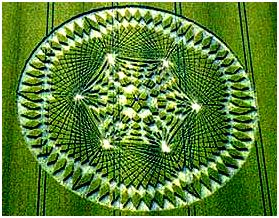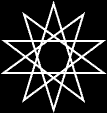An Essay on

©
2008 by Academic Services International, Los Lunas, NM, USA
![]()
.
Appendix B
The Symbology of Numbers 6 - 10
The Number Six (6) represents harmony and the macrocosm. In mundane numerology, it is the number of the professional and of responsibility. In general terms, it is the number of god, but only when compared to the number five.
The number five is man - the microcosm (the little world).
The number six is god - the macrocosm (the big world).

Six is symbolized as a hexagram or hexagon. The hexagram depicts two interlaced or overlapping triangles - the ascending triangle represents the three-fold, aspiring human (body-emotions-mind), while the descending triangle is the cosmic force (higher mind-intuition-spirit).
This design is commonly associated with an ancient Tantric
Sex Magic symbol, a Qabalistic symbol, the Star of David, Solomon's Seal, and the sign of Judaism. However, it has always been an universal symbol - with the Jewish association developing gradually - It began as the symbol of the Jewish community in Prague in the 17th century and only became generally recognized as the symbol of the Jews in the 19th century.
An image of the Sun or a star, or any point of light captured on film or diffracted from a polished gemstone, usually displays six rays. The image of six points and/or arms appears to be the most common theme in geometrically balanced crop circles.
The standard hexagram cannot be drawn in one continuous line,
but has to be constructed from two separate triangles. Unicursal (one-line) forms are convenient for ritual work as symbols are traced in the air with magical instruments, and a unicursal hexagram was devised for this reason by a member of the Order of the Golden Dawn.
. . . . . . . .
All hexagrams represent the union of the macrocosm with the microcosm, and the unicursal version demonstrates this with a single line, thus affirming the ultimate unity of the two.
It is possible that a magician might enact a ceremony based on the number 6, although this is not necessarily a common arrangement.
. . . . . . .
The Number Seven (7) depicts the levels of consciousness and is a symbol often used to represent the feminine. In mundane numerology, it is the number of the philosopher or the librarian that represents a withdrawn person who likes to read a lot (and be left alone). In more general terms, it is the number of metaphysics.
Seven is portrayed as a septagram or septagon. A septagram is the
seven-pointed star, a symbol of synthesis and mystery. Seven is an integrating number, encapsulating as it does the hierarchical orders of classical mystical thought:
There are seven planetary spheres governed by the seven planets of classical astrology, seven colors in the rainbow, seven days of the week, seven chakras (centers) in a human form, seven distinct energy fields in the aura, and seven notes in a diatonic musical scale.
However, the Chinese musical scale only has five notes.
Seven and the septagram can be considered as representing the sum of Heaven and Earth, alluding to the seven directions of space - two directions for each dimension plus the center.
It is possible that a magician might enact a ceremony based on the number 7, although this is not necessarily a common arrangement.
The Number Eight (8) depicts fullness and is a symbol of prosperity. In mundane numerology, it is the number of the businessman (-woman).
The eight-pointed star, known as the octagram, is a symbol of regeneration. Through linkage to the great eight-fold trigrams of the I Ching, the octagram demonstrates wholeness, rebirth, and cyclical infinity.
The association with infinity is reinforced by the lemniscate, the common symbol for infinity that takes the form of a figure eight on its side ...
... and through its correlation with the eight primal deities of ancient Aegypt, the ogdoad:
The octagram's associated polygon, the octagon, is intermediate between square and circle, moving fixed manifestation towards the infinite and confirming the sense of spiritual regeneration. For this reason, many baptismal fonts are octagonal.
It is possible that a magician might enact a ceremony based on the number 8, especially considering that eight is a common number when the four directions are divided.
The Number Nine (9) depicts completeness and is a symbol of initiation. In mundane numerology, it is the number of the spiritualist.
The nonagram, or nine-pointed star, is a symbol of achievement, supreme sanctity and, as the last single digit in our decimal number system, it is a number of fulfillment and limits. It is also a number of great depth and people influenced by 9 (through their name or date of birth) are often unfathomable by persons ruled by other numbers.
Nine is composed of a trinity of trinities (3 x 3), thus it represents the utmost sacredness. The nine points of the nonagram radiate all these connotations. There are nine known planets in the solar system and nine Muses of Greek mythology.
Nine is the number of deities in the Great Ennead of Heliopolis, headed by Ra and followed by Shu and Tefnut (deities of air and moisture), Geb and Nut (earth and sky), Osiris and Isis, and Set and Nephthys.
It is possible that a magician might enact a ceremony based on the number 9, although this is not necessarily a common arrangement.

The Number Ten (1Ø) depicts a result and is a symbol of the material world. In mundane numerology, it does not exist - for the temporal system deals only with single digits. Thus 10 (1 + 0) is reduced to 1 (1 + 0 = 1).
In Qabalistic terms, ten is Malkuth (the Kingdom) and is not considered to be a principle of, but rather an appendage to, the Tree of Life - It is suspended below the nine principles of the Tree and is where all the higher forces manifest and come to bear. Welcome to Planet Earth!
Its geometry is the Decagram, or ten-pointed Star, composed of two interlocking Pentagrams: one upright and one inverted. It operates as a doubling of the Forces. Malkuth is the Four Elements plus the Spirit (Aethyr) which rules them, in both positive and negative polarities. It is the final balance of all the Forces of the Tree operating together.

It is possible that a magician might enact a ceremony based on the number 10, although this is not a common arrangement.
.
.
.